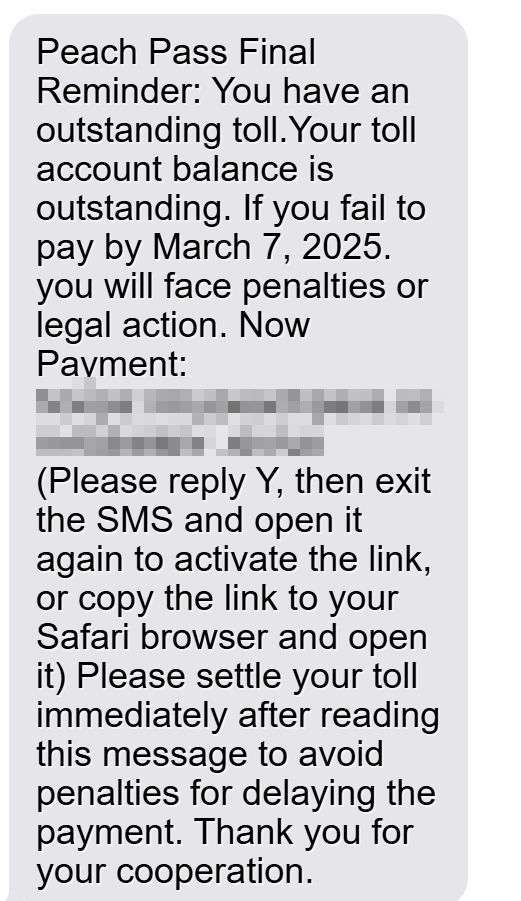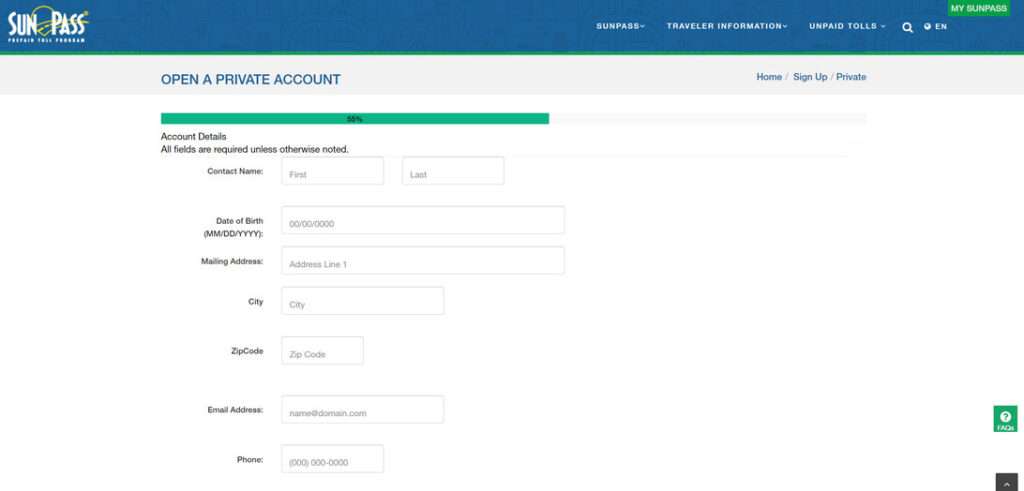They say nothing in life is free – not even those open roads. For drivers across many parts of the US, tolls and electronic toll collection systems like E-ZPass, SunPass, and Peach Pass are facts of life. Millions dutifully pay to use these toll roads every day.
But some dishonest scammers want to cheat the system and trick you into paying toll fees that don’t exist.
One common toll road scam making the rounds is the “You Have An Outstanding Toll” text message. Scammers are sending SMS messages claiming you owe money for driving on a toll road. The messages threaten penalties or legal action if you don’t pay right away.
This article will break down exactly how the “outstanding toll” scam works, what scammers want, and most importantly, how to protect yourself.

Overview of the “You Have An Outstanding Toll” Scam
This toll fee scam starts with an unsolicited text message sent to your mobile phone. The message claims to be from an electronic toll system provider – often E-ZPass, SunPass, or Peach Pass.
It says your toll account has an unpaid “outstanding balance” and threatens penalties or legal consequences if you don’t settle the debt immediately.
A fake payment link is included, directing you to enter personal and payment information to pay off the nonexistent toll balance.

In reality, the text is not from any legitimate toll agency. It’s from scammers trying to scare you into handing over your sensitive data and money.
Some key facts about this “outstanding toll” scam:
- Originates from unknown numbers with no caller ID.
- Uses scare tactics with threats of penalties and legal action.
- Directs victims to click shady links to fake toll agency websites.
- Asks for personal info like name, DOB, address.
- Requests payment info including credit card numbers.
- Leads to identity theft and unauthorized charges.
This scam proliferated rapidly across the US in 2022. Security experts attribute the spread to digitized databases of names, cell numbers, and license plate details being sold on the dark web.
Armed with chunks of compromised personal data, scammers can make unsolicited messages seem more legitimate and target victims more precisely.
But make no mistake – these “pay your outstanding toll” texts are frauds. The scammers are criminals seeking to exploit and steal from innocent drivers.
How the “You Have An Outstanding Toll” Scam Works
Let’s break down step-by-step how scammers carry out the “outstanding toll” scam:
1. Victims Receive Unsolicited Text Messages
The scam starts with an unsolicited text message sent to the victim’s mobile phone.
The message claims to be from a toll road provider like E-ZPass, SunPass or Peach Pass. It says the victim has an unpaid toll balance and owes money.
Here’s an example scam message:
Peach Pass Final Reminder: You have an outstanding toll.Your toll account balance is outstanding. If you fail to pay by March 7, 2025. you will face penalties or legal action. Now Payment: [
[phising link](Please reply Y, then exit the SMS and open it again to activate the link, or copy the link to your Safari browser and open it)
Please settle your toll immediately after reading this message to avoid penalties for delaying the payment. Thank you for your cooperation
The texts appear to come from a legitimate toll agency. But they actually originate from unknown numbers and often use bogus caller ID.
2. Messages Threaten Consequences for Nonpayment
The text messages amp up the scare tactics by threatening repercussions if the outstanding toll fees aren’t paid immediately.
Some examples of intimidating threats seen in scam texts:
- Your registration will be suspended.
- A lien will be placed on your property.
- You will face additional fines and penalties.
- Legal action will be taken.
These are all empty threats, but scammers include them to pressure and frighten victims into taking action.
3. Fake Toll Agency Links Included
A link is conveniently included with instructions to pay off the “unpaid” toll balance.
The link seems to go to the website of the toll road provider. But it actually takes victims to convincing fake sites controlled by scammers.
Victims are told to “verify” their account, settle the outstanding balance, or avoid penalties by clicking the link. But it’s a ruse to steal personal and financial information.
4. Victims Asked to Enter Personal, Payment Data
On the scam toll agency sites, victims are prompted to enter an array of sensitive personal details including:
- Full name
- Home address
- Phone number
- Email address
- Vehicle information
They are then pushed to enter payment information such as:
- Credit/debit card numbers
- Security codes
- Expiration dates
By voluntarily handing over this data, victims enable scammers to commit identity theft and unauthorized charges.
5. Criminals Steal Money and Identities
With the stolen payment card details, scammers can charge bogus toll fees or purchases directly to victims’ accounts.
Meanwhile, personal info like names, addresses and DOBs can be used to commit tax fraud, take out loans in the victim’s name, or sell on the dark web.
Victims’ identities get hijacked and accounts emptied out. Later they are left dealing with the aftermath like fraudulent charges and damaged credit.
Official Toll Agencies Will Not Contact You Via Text
It’s important to remember that legitimate toll agencies like E-ZPass, SunPass, and Peach Pass do not contact drivers by text message to collect unpaid balances or tolls.
If you truly have any outstanding toll debt, these agencies will send an official mailed notice to your address associated with the toll account.
E-ZPass, SunPass and other reputable toll operators will never text or email you out of the blue demanding payment. Any such unsolicited electronic communication claiming you owe toll money is almost guaranteed to be a scam.
If you receive a suspicious text message about unpaid tolls, do not interact with it. Instead, contact your toll provider directly through their official website or phone numbers to check if you have a balance due.
Any legitimate outstanding toll fees will show up on your account that way, without the agency resorting to threats via text.
Remember, if the notice comes by text, it’s a scam designed to steal your money and information. No matter how convincing the texts may seem, real toll agencies will not text you regarding debts – they will send paper notices by mail.
Checking your account balance directly rather than trusting unsolicited messages is the best way to avoid falling for a toll payment scam.
What To Do If You Get a Fake Toll Text
If you receive a suspicious text message claiming you have unpaid toll fees, here are important steps to take:
- Don’t click on any links – they likely lead to fake lookalike sites designed to steal your information.
- Don’t call back phone numbers in the message – they are usually spoofed.
- Don’t reply to the text at all. Scammers may use your reply to confirm they reached a real number.
- Don’t provide any information if you followed a link before realizing it was fraudulent.
- Bookmark/save the message as proof of the scam attempt.
- Search online to confirm the message format matches known toll scams.
- Report it to your state AG’s office and the FTC’s spam reporting tool.
- Call your toll account provider using an official number to verify if any balance is really past due.
- Request account alerts so you are notified of legitimate charges.
- Monitor statements for any unauthorized charges from scammers.
- Change passwords as a precaution in case of a security breach.
- Consider blocking the sender’s phone number to prevent more messages.
FAQs on the “You Have An Outstanding Toll” Scam
What is the “You Have An Outstanding Toll” scam?
This is a scam where victims receive a text message claiming they owe money for unpaid toll road fees. The messages threaten penalties if victims don’t pay immediately by clicking a link to a fake website. Scammers are trying to steal personal information and money.
What toll agencies are being impersonated in this scam?
Scammers often pretend the messages are from toll agencies like E-ZPass, SunPass, and Peach Pass. But legitimate toll agencies don’t contact drivers by text to demand payment.
What threats do the scam messages make?
The texts threaten consequences like registration suspension, liens, penalties, fines, and legal action if the fake toll fees aren’t paid right away. These are empty threats meant to frighten and pressure victims.
What do the scam messages ask victims to do?
The texts instruct victims to click a link and enter personal and payment details to settle the nonexistent unpaid toll balance. The link leads to a fake website controlled by scammers.
What is the scam website used for?
On the fraudulent website, victims are prompted to enter sensitive personal information including names, addresses, DOBs. They are also pushed to provide payment data like credit card numbers that scammers can use to steal money.
What should I do if I receive an “outstanding toll” scam text?
Do not click any links, provide any personal or payment information, call back any numbers, or reply to the text. Report the scam to authorities. Check directly with your toll account provider to confirm if any balance is actually past due.
How can I protect myself from the “unpaid toll” scam?
Be wary of threats made through unsolicited calls, texts, and emails regarding toll debts. Never click on links or provide information to any unverified sources. Monitor your account routinely for any unauthorized charges made by scammers.
Where can I learn more about toll payment scams?
Your state attorney general’s office and consumer protection agencies have more information about latest toll road scams and how drivers can avoid falling victim. Report all suspicious messages to help authorities track frauds targeting motorists.
The Bottom Line – Protect Yourself
The “outstanding toll” scam is just one of many toll frauds targeting drivers across the US. With schemers constantly cooking up new scams, drivers need to stay vigilant.
Remember – legitimate toll agencies will never threaten penalties without first sending account notices by mail. Any call, text, or email threatening consequences for unpaid tolls is almost certainly a scam.
Safeguard your personal and financial information by never clicking links or providing data to unsolicited messages. Avoid toll account fraud by monitoring statements routinely and reporting suspicious activity.
Defensive driving applies to your finances too. With awareness of the latest toll payment scams, you can detect frauds, steer clear of traps, and protect your identity.










